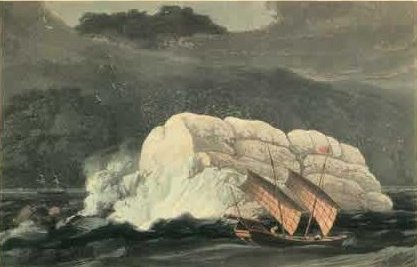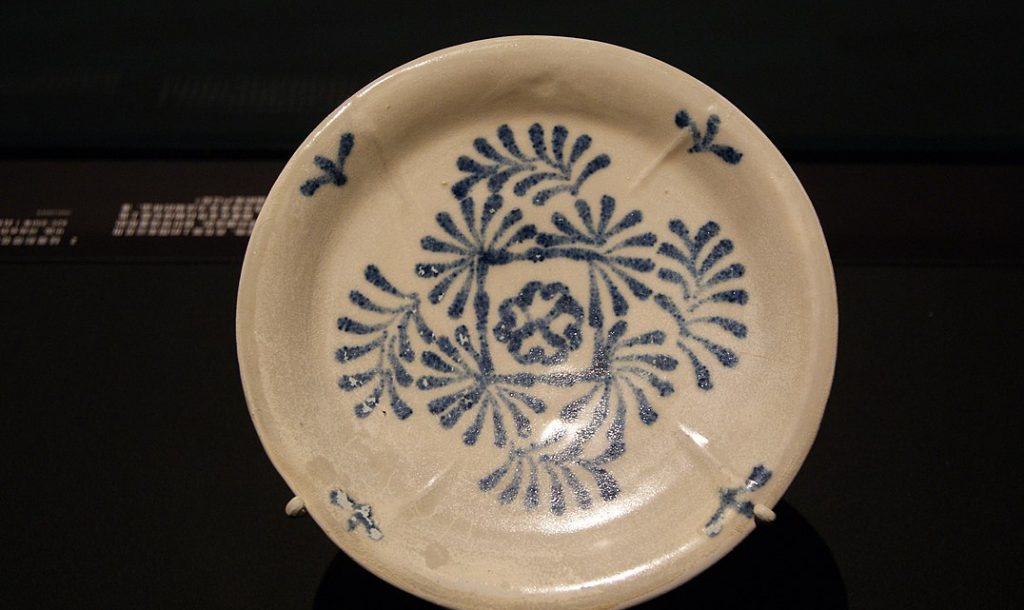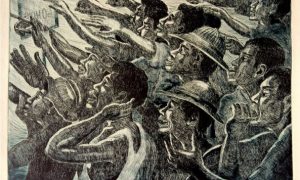The recent discovery and salvage of two wrecks in Singaporean waters, tentatively dated to the 14th and 18th centuries, exemplifies the potential of sunken ships to transform our understanding of the historical eras in which they set sail. The first of these, located about 100 metres to the north-west of Pedra Branca – a tiny, uninhabited island at the eastern end of the Singapore Strait – came to light in 2015, when divers hired to clear the surrounding seas of scrap metal found a submerged ceramic treasure trove. By chance, one of these divers recognised a striking similarity with ceramics excavated around the same time from Empress Place, the significance of which had attracted extensive media coverage. The divers were civic-minded enough to hand their finds to the ISEAS – Yusof Ishak Institute, which led an archaeological survey of the shipwreck site in 2016. Under the guidance of renowned maritime archaeologist Michael Flecker, a second wreck was located and identified as the Shah Munchah, an East India Company vessel that sank in 1796 on its return from China to India. The cargoes of both ships were recovered in a series of diving expeditions completed earlier this year.
This article is based on research first shared as part of the Sydney Southeast Asia Centre’s ‘Heritage and the Arts’ webinar series.
The most intriguing aspect of these wrecks is the discovery, in what remains of the older vessel, of the most substantial cargo of Chinese Yuan-dynasty (1271-1368) blue-and-white ceramics ever found in Southeast Asian waters. The quantity of these pieces far exceeds earlier finds, while the similarity of celadon-glazed wares carried by the same ship with examples found at Empress Place, dated to the late 14th or early 15th century, indicates that at least part of the cargo may have been intended for local circulation. It is not only the unprecedented quantity, however, but also the astounding quality of these blue-and-white wares that renders their discovery so remarkable and potentially transformative for our understanding of the China Trade in Southeast Asia.
There has long been a persistent assumption among scholars of the China Trade that the greatest reverence for Chinese ceramics in the region, and their most receptive market, could be found among the indigenous communities of the Philippines and Indonesia. Unfamiliar with the source of these goods and the methods of their manufacture, the argument goes, indigenous collectors were unanimously captivated by the translucent fragility of porcelain and the inscrutable designs with which such wares were adorned, regarding them not merely as functional commodities but powerful talismans of cosmological significance. Imported ceramics therefore became a vehicle for cementing alliances, easing the transition to ancestral realms, healing dire spiritual sicknesses, revealing prophesy, or mediating between human and other worlds. An implicit, and sometimes explicit contrast has frequently been drawn between this context of use and that which prevailed in Europe and the Middle East, where a comparable tendency toward awestruck speculation has largely been overlooked by scholars who emphasise the ornamental uses of Chinese ceramics in the domestic interiors of the wealthy.

An etching of Pedra Branca before the building of Horsburgh Lighthouse, with dark storm clouds in the background. C. 1820. Thomas Daniell (1749–1840) and William Daniell (1769–1837). (Public domain)
A related and equally persistent assumption is the claim that Southeast Asian buyers of Chinese ceramics only enjoyed access to low-quality wares, and that Chinese kiln-owners and merchants regarded this market to the south as a “dumping ground for [their] coarsest products,” as historian Robert Finlay phrased it in The Pilgrim Art: Cultures of Porcelain in World History (2010). This is an assumption to which eminent ceramics historian John Guy drew attention in his brilliant 2021 S.T. Lee Lecture, noting a tendency to assume “that ceramics circulating in Southeast Asia were of pedestrian quality, [although] this was [certainly] not the case.” While Finlay does concede in The Pilgrim Art, now considered by many to be essential reading for students of the China Trade, that wealthy port-city residents also bought Chinese wares, he maintains that “harbourmasters, administrative officials, and urban businessmen” of the entrepot accumulated these products “as a commercial resource [to be traded with] peoples unfamiliar with structured governments and complex economies,” little more than “a bankable cultural asset.”
Against this definition of Chinese ceramics in Southeast Asia as politically potent yet aesthetically inferior commodities, those found in the cargo of the Pedra Branca wreck present evidence for a parallel yet frequently overlooked market for luxury among the region’s wealthier inhabitants. The blue-and-white wares discovered in this submerged cargo are a far cry from the coarse cast-offs that Finlay imagined as the only porcelain available in the region. Rather than an indictment of Finlay’s scholarly acumen, however, such contradictions are a marker of the limited evidence on which understandings of the China Trade in Southeast Asia are based, and of the abrupt shifts that a new discovery can set in motion.
In our search for traces of this overlooked market for Chinese ceramics, the many ships that have succumbed over the centuries to unpredictable weather or hidden reefs, coming to rest on the ocean floor with their cargo and many of their crew, offer an invaluable source. Writing for New Mandala in 2018, critical heritage studies scholar Natali Pearson makes a compelling case for the value of these wrecks:
Shipwrecks are incredible resources for scholars of the past, providing a unique insight into a single moment in time … [O]ften described as time capsules … they encapsulate so much information about the life of the crew, the technology used to construct the vessel, and the unique make-up of [their] cargo … [Unlike] temples or mausoleums … purposely constructed in the present for the future, a shipwreck is the result of an accidental event [and] is therefore … more indicative of life as it ‘actually was’, rather than as the people of the past wished us to see it.
Pearson acknowledges that shipwrecks have limitations as sources for understanding the distant past, noting the “challenges of working with degraded organic materials” and “discrepancies in dates and origins,” not to mention the difficulty encountered in simply gaining access to these materials, which are all too often dispersed by looting and private sale. As an artefact of a singular series of commercial decisions, the extent to which a wreck can be used as the basis for general speculation is also constrained. Yet this can equally be an advantage—the possessions of those onboard, as well as the cargo they were paid to transport, can provide a microhistory from which broader patterns of market distribution and daily life can be extrapolated.
At the turn of the twenty-first century, for example, the excavation of the Belitung wreck near the island of that name in Indonesian waters – also coordinated and initially reported by Flecker—prompted a crucial revision of previously long-held assumptions. Like the Pedra Branca wrecks, the Belitung wreck was discovered by local divers – hunting this time for sea cucumbers rather than scrap metal—who stumbled by chance across a cache of ceramics. Recognising the historic (and monetary) value of their find, the divers sold the coordinates to Seabed Explorations GBR, a German salvage company permitted to excavate and sell artefacts on the private market under Indonesian heritage legislation in place from 1989 until a moratorium on commercial salvage in 2010, during which time several of the most significant wrecks found in the region were located and picked clean. But, in the case of the Belitung wreck, the entire assemblage remained intact and now resides in the Asian Civilisations Museum, Singapore.
This preservation has enabled scholars to study the wreck and its contents at leisure, leading to several important conclusions. By comparing Chinese coins found at the site, a date engraved on one of the 50,000 Changsha ware ceramics that comprised the bulk of the cargo, and radiocarbon testing of the ship’s timbers, for example, archaeologists and art historians have dated the wreck to a remarkably precise four-year interval between 826 and 830. It is the identification of the ship itself as an Arab dhow, however, that has proven most remarkable. Prior to this, it had generally been assumed that trade in Southeast Asia at this time was primarily regional, with small ships transporting goods from harbour to harbour as needed, rarely venturing far. The Belitung wreck forced a radical reappraisal of the trading routes linking China, Southeast Asia, and the Middle East. The quantity and quality of the cargo, as well as the likelihood that it had been specially commissioned by a wealthy patron as a single bulk order of idiosyncratic design, indicated that the scale and complexity of this trade were much greater than previously thought.
Looking beyond Southeast Asian waters, the Sinan wreck located in the islands of South Korea’s Sinan County in 1975 provides a paradigmatic case-study for the extent to which such discoveries can not only set in motion new chains of thought but also ossify existing assumptions, even in the face of mounting contrary evidence. This wreck remains the standard point of reference for scholars who assert that blue-and-white ceramics were not produced in China until the mid-14th century, despite the subsequent discovery of earlier pieces in Chinese kiln sites and other wrecks—including the Belitung wreck. The complete absence of such wares in the salvaged cargo of this vessel, the argument goes, presents incontrovertible evidence for their non-existence. Yet many points could be raised to counter this claim. Above all, like the Belitung wreck, this cargo could be a single bulk commission manufactured to suit the tastes of a wealthy client, and so cannot be taken as a representative sample of the range of ceramics available at the time of purchase and transport. Even if intended for wider distribution, the type of wares selected for trade likely reflect the tastes of a single market.
Nevertheless, despite these counterclaims and the discovery of blue-and-white ceramics that predate the Sinan wreck, many scholars still repeat the conventional narrative. This origin story remains central to the established mythology of global ceramic innovation, whereby the import of Song-dynasty celadon-glazed wares to the Middle East is said to have sparked an exchange of raw materials and design choices that culminated in the invention of blue-and-white. The urtext for this narrative can be traced to two sources published within a few years of the Sinan discovery: Margaret Medley’s discipline-defining The Chinese Potter: A Practical History of Chinese Ceramics (1976) and an article penned for Hong Kong-based journal Orientations by art historian Duncan Macintosh in 1973. Together, these have been canonised as a largely unimpeachable triumvirate to which almost all subsequent scholars must pay their respects. The authority of this scholarly lineage and the sweeping narrative to which it has given rise, however, obscures the much more complex networks of exchange within which blue-and-white circulated, inspiring an enormously diverse range of responses across different regions, cultures, nations, and even social groups.
If we take the Pedra Branca wreck as a case-study for larger patterns of trade, we can reasonably argue that the quality of blue-and-white onboard suggests a local market for Chinese ceramics that rivalled the Islamic and European courts which dominate studies of the China Trade. In the absence of a surviving intact collection, we can only guess at its extent and character, but this need not be an insurmountable obstacle to our reconstruction of the past. We cannot know how such wares were regarded and received by those for whom they were intended, yet we must consider them as more than just specimens in a typology of Chinese ceramic development or as export commodities that represent one of many stages in the expansion of a global commercial network. We must see them instead as materials for the expression of multiple forms of identity in their contexts of use and appreciation, even if these can now only be partially reconstructed.
The race to save up to 50 shipwrecks from looters in Southeast Asia
How should we respond when heritage is damaged or destroyed?
We should also dispense at last with the persistent belief that Southeast Asians only had access to the lower end of the market: the blue-and-white porcelain found in the Pedra Branca wreck includes several high-quality pieces that would not have looked out of place in the cosmopolitan courts of Europe and the Middle East. Against a prevailing emphasis on these courts, this salvaged cargo draws attention to the pivotal role played by Southeast Asian merchants and consumers in the circulation of Chinese ceramics. Without surviving examples or intact collections of secure provenance, however, to reconstruct this role we must turn instead to various traces that these long since dispersed wares have left behind: literary references, artistic impressions, spaces for the storage and display of treasured possessions, and evidence of appropriation or adaptation in local ceramic traditions. The masterful research that John Guy shared in his S.T. Lee Lecture is a model case-study for this approach, drawing on manuscript illustrations and literary evidence as well as archaeological finds to flesh out our understanding of the place of Chinese porcelain in Sultanate and Mughal India. It is only with recourse to such tactics of salvage and conjecture that we can hope to grasp the parallel complexity of Southeast Asian responses to blue-and-white.
 Facebook
Facebook  Twitter
Twitter  Soundcloud
Soundcloud  Youtube
Youtube  Rss
Rss 



